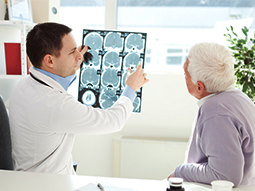This is a rare condition in which the arteries supplying the brain progressively narrow over time. The carotid arteries at the base of the brain are often affected. Because the brain is deprived of blood flow, other arteries (called collaterals) compensate by becoming abnormally enlarged.The compensation is often inadequate, and strokes can occur.
On a cerebral angiogram (imaging study of blood vessels), the enlarged collaterals in Moyamoya disease often appear like a puff of smoke. “Moyamoya” means “puff of smoke” in Japanese.
Causes of Moyamoya disease
In many cases, this disease is idiopathic (no known cause). Sometimes, however, it can be associated with:
- Family history
- Japanese or Korean heritage
- Sickle cell disease
How is Moyamoya disease diagnosed?
Most patients with this very rare disease are diagnosed after they present with a stroke or TIA (transient ischemic attack, also known as a “mini-stroke”). A noninvasive imaging study called MRA (magnetic resonance angiography) will reveal Moyamoya disease, if it is present. MRA uses powerful magnets to “map” the brain and arteries.
Your Moyamoya specialist may also recommend a cerebral angiogram to evaluate the severity of your disease and plan treatment. A cerebral angiogram allows your surgeon to visualize the pattern of blood flow to the head in real-time, by injecting a contrast dye into the arteries.
Moyamoya disease treatments
At MedStar Health, we are a premier center for the treatment of adult Moyamoya disease in Washington, D.C., Vikram Nayar, MD, is one of a select few neurosurgeons in the mid-Atlantic region with expertise in bypass surgery, the procedure used to treat this condition.
Learn more about the Moyamoya disease treatments we offer at MedStar Health.
Our providers

Expert neurology care
Getting the care you need starts with seeing one of our neurologists.









